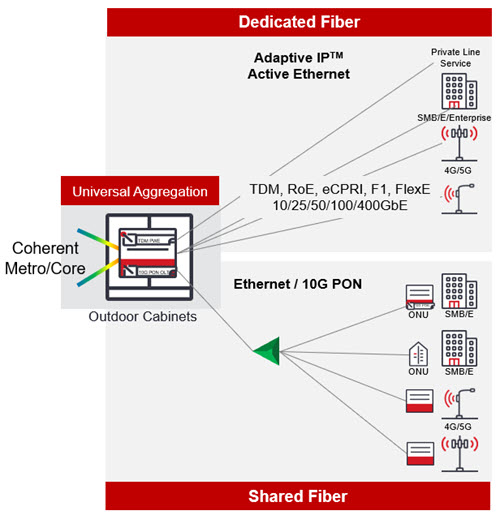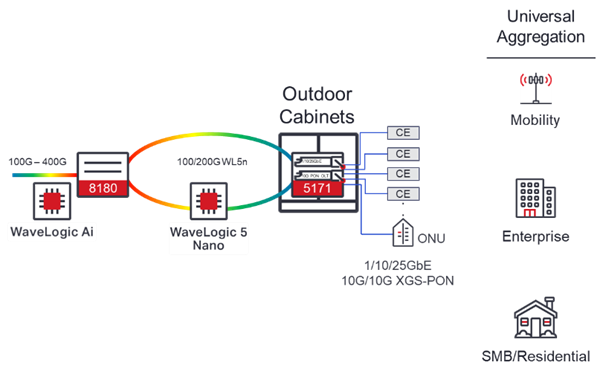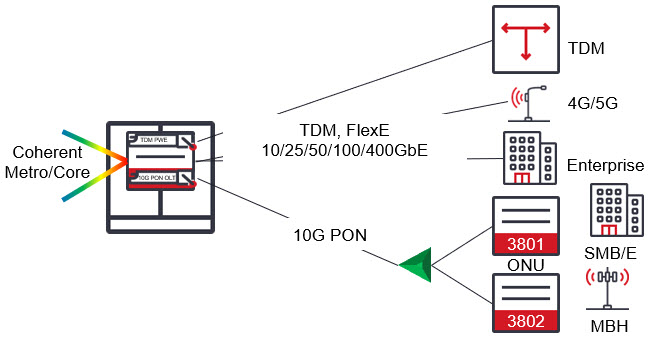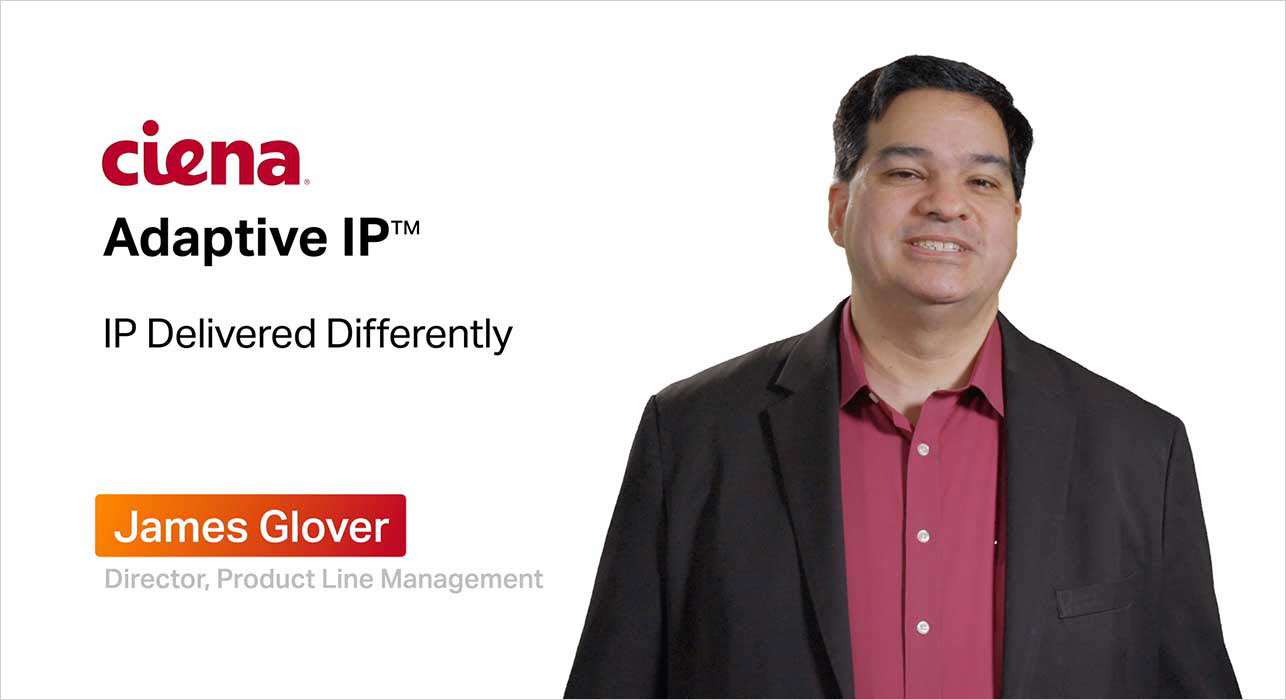Universal aggregation for Cable MSOs
In part one, of this three-part blog series on Universal Aggregation, I discussed how Mobile Network Operators (MNOs) and virtual network aggregators, enablers, and operators (MNVAs, MNVEs, and MNVOs) alike sell converged network services on a common transport network. In this blog, I’ll discuss a similar industry goal for Cable Multiple-System Operator (MSO) networks. The third and final installment in this three-part series will discuss Service Provider (SP) networks.
With a massive amount of OTT demand, IoT, M2M, mobile and many more new services, it should come to no one’s surprise cable network operators have invested in deploying fiber deeper into their networks. Their goal is to increase service speeds by investing heavily in their access networks to accommodate future service growth and ensure their advertised speeds and services surpass the competition. To do so they will need an architecture that leverages universal aggregation.
What is universal aggregation?
Universal aggregation provides increased choice and control of tangible business value assets like coherent optics, pluggable dedicated and shared fiber, and Ciena’s Adaptive IPTM. By supporting all services, including mobility, universal aggregation expands the network provider’s application space and competitiveness. A smaller footprint, increased capacity, and larger interconnect scale in platforms that automate and simplify deployment and turn-up tasks, facilitates increased choice to network operators.

Universal aggregation solution
Increasingly, cable operators are looking to universal aggregation solutions to solve several business challenges. Universal Aggregation provides the right speeds, feeds, and routing capability to support traffic from multiple different service types, including private line, business services, mobile, shared fiber, or Passive Optical Network (PON). By unifying packet and optical transport infrastructure, and best of all, it enables a simple, compact, scalable, and efficient programmable infrastructure with coherent optic transport, switching, and routing capabilities for Cable MSO services now, and well into the future.
The challenges of multi-vendor, multi-layer network infrastructure
The cable network is increasingly difficult and complex to manage and support. Maintaining legacy optical transport, switching, and routing networks means that delivering new services requires rolling out new ‘overlay’ networks. This also increases the complexity of the operating environment, making the network more difficult and costly to manage and support. This negatively impact operating margins and the ability to troubleshoot and address issues quickly enough to ensure an expected customer quality of experience.
For most cable operators, their environment is very challenging with multiple vendors deployed for TDM, Ethernet, IP, and PON. For most cable customers, the vast majority of the distance a service travels is over optical fiber, which connects multiple types of equipment, including digital fiber nodes, Ethernet, IP, private line, and PON.
With the exception of point-to-point shared fiber or PON, dedicated fiber is used or aggregated. In particular, PON has been extremely popular over the past 15 years, using large purpose-built Optical Line Terminal (OLT) chassis. As cable operators look to keep up with network growth, estimated to be at least 10x in the next decade, symmetrical 10G PON technology will be an important tool used to migrate.
In the previous blog, I pointed out a number of potential risks without addressing infrastructure sprawl scale, and complexity. To ensure services remain profitable, cable operators need a new approach to infrastructure design and deployment. Instead of building out new optical and Layer 2/3 infrastructure to add new capacity and support new services, cable operators should consider redesigning their network architecture based on Universal Aggregation.

Potential multi-vendor, multi-Layer risks
WaveLogic Coherent Networking

WaveLogicTM Coherent Networking
As the network edge emerges as a critical location for connect, compute, and store, cable operators are evolving from building separate, siloed networks. Coherent packet-optical technology plays an increasingly critical role in solving networking challenges related to improvements in capacity, costs, and competitiveness. Increasingly, cable operators look to coherent packet-optical technology to solve the scalability and cost per bit challenges in their network.
The use of modern, coherent packet-optical technologies, and advanced packet networking technology in the same platform, is a key benefit in eliminating cost and complexity associated with deploying separate packet and optical devices.
By harnessing strong performance and programmability offered by Ciena’s WaveLogicTM family of coherent optics, cable operators can maximize performance capacity at any distance. While pluggable coherent optics can address the needs of next-generation Cable MSO access, including extended temperature support for street-level cabinet deployment of outdoor aggregation as shown above, with the possibility of future pole mounted devices.|
Cable MSO benefits of universal aggregation
The value of universal aggregation is simple – choice! Choice from having to building different access networks for different Cable MSO services. Choice from having different fiber for different services with unified fiber for different mobile services. Choice from aggregation for different services to aggregation for all services. Choice from closed Network Management Software (NMS) to open source streaming telemetry. Choice from having network revolutions to an evolution for all of your services.

Universal aggregation services
A new simplicity for the Cable MSO Operators
Ciena’s Universal Aggregation solution allows flexible, open deployments supported by our feature-rich extensive Packet Networking portfolio. Instead of building siloed, standalone architectures to support different types of services, cable operators can now bring more value to their networks by supporting concurrent PON, IP, and Ethernet services on the same Ciena aggregation platform. This improves customer satisfaction, choice, and business value control.
Stay tuned, as I discuss increased choice and control of business asset value for Service Providers in the next part of Ciena’s Universal Aggregation series. To find out how to remove the constraints and bring more value to your network edge today, and ask us how Ciena helps Evolutionize Your Packet Network.
What’s in your Cable MSO Network?









